
Company Profile
Company Profile
| Company name | Fujikura Ltd. |
| Established | 1885 |
| Incorporation | 1910 |
| Paid in Capital | 53.0 billion yen (as of March 31, 2016 Consolidated) |
| Net Sales | 678.5 billion yen (FY2015, Consolidated) |
| President & CEO | Masahiko Ito |
| Head Office | 1-5-1, kiba, koto-ku,Tokyo 135-8512 Japan |
| Plants | Sakura,Suzuka, Numazu, Ishioka |
| R&D | Tokyo, Sakura, Suzuka |
| Branch/Business office | Osaka, Nagoya / Utsunomiya, Toyota |
| Overseas | U.S.A, U.K, Singapore, Malaysia, Thailand, China, Vietnam, India etc.U.S.A, U.K, Singapore, Malaysia, Thailand, China, Vietnam, India etc. |
| Number of Employees | 52,114 ( as of March 31, 2016 Consolidated) |
| Main Business | Optical Fiber Cable, Optical Tele System, Tele System, Electronics & Automotive Components, Metal Cable & System, Metal Wires, Real Estate Business,etc. |
Company history
| Beginning | 1885 | Zenpachi Fujikura commenced the manufacturing business in Awaji-cho, Kanda, Tokyo. | 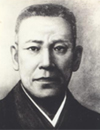 Zenpachi Fujikura 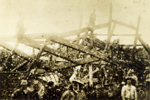 Sendagaya Plant totally destroyed by a tornado (1903) |
|---|---|---|---|
| 1887 | Imported five leading-edge braid machines | ||
| 1888 | Leasing of a former silk mill in the Shinjuku Imperial estate, Tokyo and relocation of the plant to this site (Shinjuku Plant) | ||
| 1890 | Relocation of plant to 900, Sendagaya, Tokyo. (The Sendagaya Plant 1) | ||
| 1896 | Relocation of plant to 922, Sendagaya. (The Sendagaya Plant 2) | ||
| 1901 | Reorganization as an unlimited partnership named Fujikura Electric Wire & Rubber Co., Ltd. was founded.td> | ||
| 1903 | Appointed to be Japan's first rubber-insulation plant by Japan's former Ministry of Communications and Transportation; however, the plant was totally destroyed by a tornado. | ||
| Establishment | 1910 | Company name changed to Fujikura Electric Wire Corporation. | 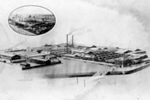 The Sendagaya Plant (1920) |
| 1920 | The Sendagaya Plant has become very prosperous. | ||
| 1919 | Established Fujikura Gakuen. | ||
| 1923 | Moved head office plant to Fukagawa, which burned due to the Great Kanto Earthquake. | ||
| 1931 | Took top spot in the market with “Toukousen” electric wire for aircraft. | ||
| Restoration after the Earthquake and Fujikura of Technology |
1938-39 | Company's baseball club became champion two years in a row in the National Inter-City Baseball Tournament. | 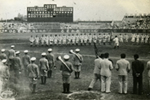 Company's baseball club became champion two years in a row in the National Inter-City Baseball Tournament. (1939) 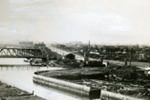 Fukagawa Plant totally destroyed in the Tokyo Air Raid, and the war finally ended. (1945) |
| 1941 Outbreak of the Pacific War | |||
| 1944 | Began operating the Fuji Plant. | ||
| Postwar and High Economic Growth Period |
1945 | Fukagawa Plant totally destroyed in the Tokyo Air Raid. (Second foundation of the company) | |
| 1945 The war finally ended. | |||
| 1949 | Delivered Japan's first 24-core TV camera cables to NHK (Japan Broadcasting Corporation). | ||
| 1954 | Opened Numazu Plant. | ||
| 1957 | Began manufacturing wire harnesses. | ||
| 1964 The Tokyo Olympics | |||
| 1965 | Opened Sakura Plant. | ||
| 1970 | Opened Suzuka Plant. | ||
| 1973 | First oil crisis | ||
| 1979年 (昭54) |
Set world record by achieving very low transmission losses of 0.27 dB/km for its single-mode optical fiber. Began manufacturing FPCs for use in electronic devices. | ||
| Period of Great Changes and Hardship |
1980 | Developed single-mode optical fusion splicers. | |
| 1981 | Developed Japan's first optical fiber composite overhead ground wire (OPGW). | ||
| 1982 | Began manufacturing membrane switches. | ||
| 1984 | Established Fujikura (Thailand) Ltd. to begin operations in the country. | ||
| 1985 | Marked centennial of the foundation. Developed world's first core alignment fusion splicer. |
||
| 1987 | Succeeded in the fabrication of oxide superconducting wires. | ||
| 1992 | Changed company name to Fujikura Ltd. | ||
| 1998 | Delivered worlds’ largest 500kV DC OF submarine cables. | ||
| Internationalization | 2000 | Commenced former Fukagawa Plant site redevelopment project. | 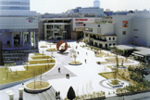 Opening of the "Fukagawa Gatharia" complex (2010) |
| 2004 | Achieved a world record for yttrium-based superconducting wires. | ||
| 2005 | Celebrated 120th anniversary of foundation, declared the "third foundation" and formulated Corporate Philosophy MVCV. | ||
| 2009 | Began conducting CSR activities and manufacture of fiber lasers. | ||
| Globalization | 2010 | Established biotope named "Fujikura-Kiba Millennium Woods". | 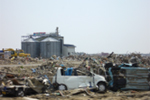 Suffered damage due to the Great East Japan Earthquake 2011 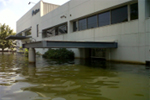 The catastrophic flood in Thailand 2011 |
| 2011 | Suffered damage due to the Great East Japan Earthquake and the catastrophic flood in Thailand. | ||
| 2015 | 130th anniversary of the foundation | ||
Global Fujikura Group
The Fujikura Group is globally operating in the following four business categories in 24 countries and regions: infrastructure-related business (power & telecommunication systems); electronics business (focusing on electronic components); automotive products business (focusing on harnesses for automobiles); and others. Of the Group’s 99 consolidated subsidiaries, 22 are operating in Japan and 77 overseas. The following table shows the breakdown of the companies by region.
(Unit: companies)
| Fujikura Group's overseas consolidated subsidiaries | By region | No. of companies by region |
|---|---|---|
| As of the end of March 2016 | ||
| Japan | 22 | |
| Asia | 28 | |
| Australia | 1 | |
| Europe | 15 | |
| Africa | 2 | |
| North America | 29 | |
| South America | 2 | |
| Total | 99 (Year-on-year comparison+0) |
The following tables show the Fujikura Group's consolidated subsidiaries by country and by business segment.
Global Fujikura Group
|
|
Number of employees by in-house company and by region
(Number of employees by business segment)
(Unit: people)
| in-house company | Fiscal 2015 |
|---|---|
| Power & Telecommunication Systems Company | 11,197 |
| Electronics Business Company | 15,969 |
| Automotive Products Company | 25,731 |
| Real Estate Business Company | 10 |
| Others | 1,207 |
| Total | 54,114 (12,705) |
*The figure shown in parentheses is the average number of temporary employees, who are not included in the total number of employees.
(Number of employees by region)
(Unit: people)
| Fiscal 2015 | |
|---|---|
| Japan | 5,670 |
| Asia (excluding Japan) | 29,025 |
| The Americas | 12,561 |
| Europe | 6,858 |
| Total | 54,114 (12,705) |
[Number of female employees, ratio]
[Unit:people]
| ① Total employees |
② Male employees |
③ Female employees |
Ratio of female(%) ③/① |
|
|---|---|---|---|---|
| Japan | 5,591 | 4,739 | 852 | 15.2 |
| Asia(excluding Japan) | 27,675 | 7,822 | 19,853 | 71.7 |
| North & South America | 12,366 | 6,037 | 6,329 | 51.2 |
| Europe & Africa | 10,931 | 4,319 | 6,612 | 60.5 |
| Total | 56,563 | 22,917 | 33,646 | 59.5 |
*Major group companies 55 companies, 56,563 employees (cover ratio 98%)
(Overseas Sales Ratio and Breakdown of Employees)
(Unit: people)
| Fiscal year | 2014 | 2015 | |
|---|---|---|---|
| Overseas sales ratio % | 54 | 60 | |
| Breakdown of employees | Japan | 5,757 | 5,670 |
| Overseas (Ratio) |
46,695 (89) |
48,444 (89) |
|
| Total | 52,452 | 54,114 | |
Introduction of our businesses
Society, industry and our Group
|
|
Participation in industry associations
Fujikura participates in a range of organizations, including industry associations, and its representatives serve as directors for the development of the industry and improvement of people's lives. The following table shows the major organizations in which the company participates.
| Name of the organization | Outline of the industrial association |
|---|---|
| Japan Business Federation (KEIDANREN) | The Japan Business Federation (KEIDANREN) is composed of 1,308 representative companies of Japan, 114 nationwide industrial associations, and 47 regional economic organizations (as of March 31, 2014). As a comprehensive economic organization, KEIDANREN contributes to the self-sustaining development of the Japanese economy and improvement in Japanese people’s quality of life by invigorating companies as well as individuals and local communities that support companies. |
| Japanese Electric Wire & Cable Makers' Association (JCMA) | The Japanese Electric Wire & Cable Makers' Association (JCMA) is an industrial association that contributes to the development of Japan's economy and improvement in the quality of life of people in Japan by fostering further development of Japan's electric wire and cable industry. |
| Japan Electric Cable Technology Center (JECTEC) | The Japan Electric Cable Technology Center (JECTEC) is engaged in the testing, examination, certification and research of the safety and reliability of electric wires and cables; human resource development in the technological field including overseas training; and information exchange and database establishment/utilization. |
| Japan Electronics and Information Technology Industries Association (JEITA) | The Japan Electronics and Information Technology Industries Association (JEITA) works to foster the sound manufacturing, international trade and consumption of electronic devices and components as well as the comprehensive development of the Japanese electronics and information technology industries, with a view to contributing to the development of Japan's economy and culture. |
| Optoelectronics Industry and Technology Development Association (OITDA) | The Optoelectronics Industry and Technology Development Association (OITDA) is committed to fostering the comprehensive growth and development of the optical industry and improving Japanese people's quality of life, thereby contributing to Japan's socioeconomic development. |
| Tokyo-to Koto Sangyo Renmei (labor insurance administration association) | The Tokyo-to Koto Sangyo Renmei (labor insurance administration association) is contributing to the development of the Koto City in cooperation with the city government and related organizations. |
| Other | |